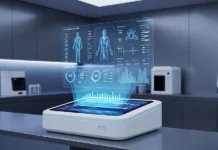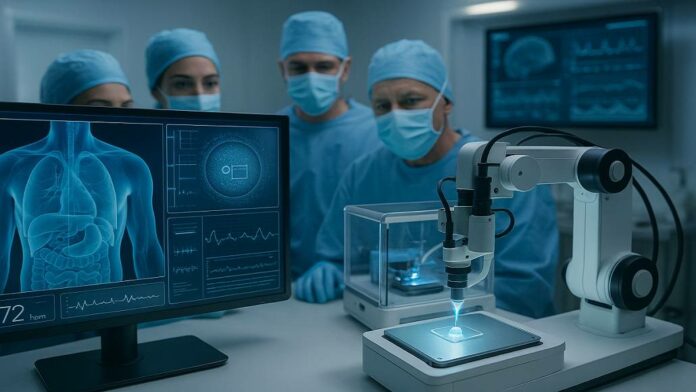When we talk of the grand theatre of modern medicine, where data reigns supreme and robots dance across the operating rooms, a quiet revolution is also shaping the very fabric of patient care. At the intersection of high-precision micro 3-D printing in healthcare and breakthrough material science, medicine is being reimagined, not with bold slogans but with microscopic details, which promise macro-level transition. This kind of convergence is not about advanced tools or futuristic therapies, but it is more about medical innovation, which redefines patient care at its very core – more effective, more personal, and far more adaptive when it comes to the real lives of patients.
Right from tools to transformation – precision as the new benchmark
While 3-D printing in healthcare happens to be no longer fresh and novel, having proved its mettle in dental implants, prosthetics, and even orthopedic guides, it happens to be the advent of high-precision micro 3-D printing in healthcare, functioning at resolutions as fine as a micron, which is indeed setting a new gold benchmark. This is not additive manufacturing as we have always known it. This happens to be nano-level engineering, which is capable of constructing structures having intricate internal geometry, which mimic the real tissues or even deliver medications at intervals that are controlled.
Just imagine, for example, a customized drug delivery implant, which is the size of a fingernail, engineered to release medication in sync with the circadian rhythm of the body. Or consider a bioresorbable scaffold printed to fit a coronary artery of a patient along with cellular-level precision, dissolving after healing. This is the medical innovation that redefines patient care – precisely, quietly, and powerfully.
What actually sets apart this new wave is not only scale but also specificity. High-precision micro 3-D printing in healthcare helps a kind of care that is fundamentally patient-matched, thereby replacing the one-size-fits-most legacy with customized solutions that are engineered to the biology of a patient.
The material transition – from plastics to living polymers
However, precision and printing are only as meaningful as the materials getting printed. What is actually fueling the next chapter of transformation happens to be a new generation of bioactive, sustainable, and programmable materials that work with the body and not against it.
Apparently, this revolution in material science has turned micro 3-D printers into biomedical sculptures that are capable of creating everything from micro needle patches in terms of painless vaccinations to living tissue scaffolds that nurture the stem cells. And the result is the treatments are no longer just about the mechanical fixes, but they are more about biological harmonious integration.
In this regard, medical innovation that redefined patient care has gone on to become not just an aspiration but an operating principle – devices that go on to adapt to the human body rather than compel the body to adapt to the device.
Therapeutic frontiers, right from regeneration to real-time treatment
It is well to be noted that one of the most striking outcomes of this convergence happens to be its impact on regenerative medicine. With high-precision micro 3-D printing in healthcare, researchers are coming up with frameworks in terms of cell growth that replicate the intricate architecture of organs as well as tissues. Early experiments have successfully gone on to print vascular networks, which have long been considered to be a barrier in bioprinting viable organs, thereby bringing the dream of lab-grown and patient-specific organs much closer to the clinical reality.
Although fully functional bioprinted organs are still some time away, the groundwork has already been laid with tissue patches, scaffold implants for cartilage and bone repair, and organ-and-chip devices. Interestingly, each success story happens to bring us closer to a future wherein organ donation shortages, waitlists, and transplant rejection shall become tales of the past.
Notably, this shift is not merely technical, but it is profoundly human. It means that there would be fewer side effects, outcomes that are better, and ultimately, treatments that work with the lifestyle of the patient and not against it.
It happens to be at its core – medical innovation, which redefines patient care in real as well as measurable ways.
Diagnostics, which are reimagined – tiny devices having massive impact
It is worth noting that precision does not stop at treatment, however; it extends into diagnostics. Micro 3-D printing enables the development of ultra-small and highly sensitive diagnostic tools that can live inside the body or even sit discreetly on the skin. These happen to include biosensors, which are embedded within wearables, ingestible microfluidic chips that evaluate the gut health, and also implantable monitors, which can track organ function, and that too in real time.
Apparently, such tools happen to be just miniaturized versions of the present diagnostics – they are a new class of medical devices that offer data in real time and that too often without the requirement for clinical visits or laboratory tests. For patients who are managing chronic illnesses, these tools go on to represent a major shift – continuous care without any kind of constant clinical intervention.
What actually crops up is a future where healthcare happens to be proactive rather than being reactive – where data as well as diagnostics flow as naturally as the blood, guiding care Much before the crisis. And once again, it is a quite force – micro printing as well as advanced materials are indeed fuelling that kind of transformation.
The integration challenges – Going beyond the clinical threshold
In spite of its promise, The pathway from The research lab to clinical use is never smooth. Regulatory frameworks are still going ahead and adapting to technologies which operate at a very fine scale and a long-term biocompatibility of certain materials has to be thoroughly validated. Besides this, hospitals and healthcare providers have to be trained not only to use, but also to trust the new devices.
Apparently, infrastructure also happens to be a factor. Micro 3-D printers are highly specialised tools which often require controlled environments, rigorous quality control, and technical expertise. These are the elements that are not always readily available within a healthcare set up as it is still grappling with digitization and labour shortages.
But the pace of adoption is certainly speeding up. There are several hospitals along with medical research centres which have established certain in-house fabrication labs that are capable of fast prototyping as well as low volume production. With advancements within AI as well as simulation software, the design process is becoming much faster and even more automated – thereby bringing People closer to a world where medical innovation which redefines the patient care is not just an aspiration, but it has turned Into a reality, which is embedded in clinical workflows.
So what is the economics of precision – value beyond expenditure?
From a market standpoint, high-precision micro 3-D printing as well as new materials are indeed redefining value within healthcare. These technologies not just offer incremental benefits but also reduce the surgical time, limit certain complications, customize the treatment, and also, in many cases, eradicate the requirement for follow-up procedures.
While the upfront investment in technology may look pretty steep, the downstream savings when it comes to hospital stays, admission rates, and medication usage are really compelling. As the expenditure of printing hardware drops as well as material supply chains mature, the economies are going to transition further in favor of a scalable rollout.
Significantly, these innovations go on to promise much greater health equity. By way of decentralizing manufacturing, along with helping low-volume, high-impact devices, rural clinics as well as underserved regions can go ahead and access tools, which at one time required intricate logistics or even urban hospital infrastructure. The democratization when it comes to precision medicine may as well be one of the most powerful long-term outcomes of it.
The ethical mandate: designing with humanity in consideration
As with many other powerful innovations, questions do arise. Who happens to own the design of a printed organ scaffold? How can patient data get integrated into AI-generated implant geometry? What kind of protocols make sure of a safe degradation when it comes to bioresorbable materials?
All these aren’t just academic questions, but they are policy challenges that have to be addressed along with innovation.
It is well to be noted that ethical innovation needs transparency, inclusivity, and even regulations that keep pace with the technology. It needs to listen to both patients as well as engineers and also create standards that protect safety without stifling progress. All put together, it demands a patient-first kind of mindset, which is precisely the mindset that goes into medical innovation that happens to redefine patient care.
In the end, the next chapter is patient-centered medicine
As we all stand at the threshold of a very new era, it is not the flashing technologies or the headline-grabbing breakthroughs that are going to define the healthcare future. It is the precision, personalization, and ability to treat every patient as a unique biological spectrum who is deserving of a therapy that is engineered and not approximated.
High-precision micro 3-D printing, along with the evolution of new materials, is not just a tool in this transition, but it is the very engine of it. Together they enable us to rethink every element of the patient journey, right from diagnosis to treatment to even recovery, not as a discrete stage but as a connected whole designed with intention as well as intelligence. This is the kind of promise and proof of medical innovation that defines patient care. It’s not just about the future of medicine. It is the medicine of the future, which is quietly reshaping every layer.


















